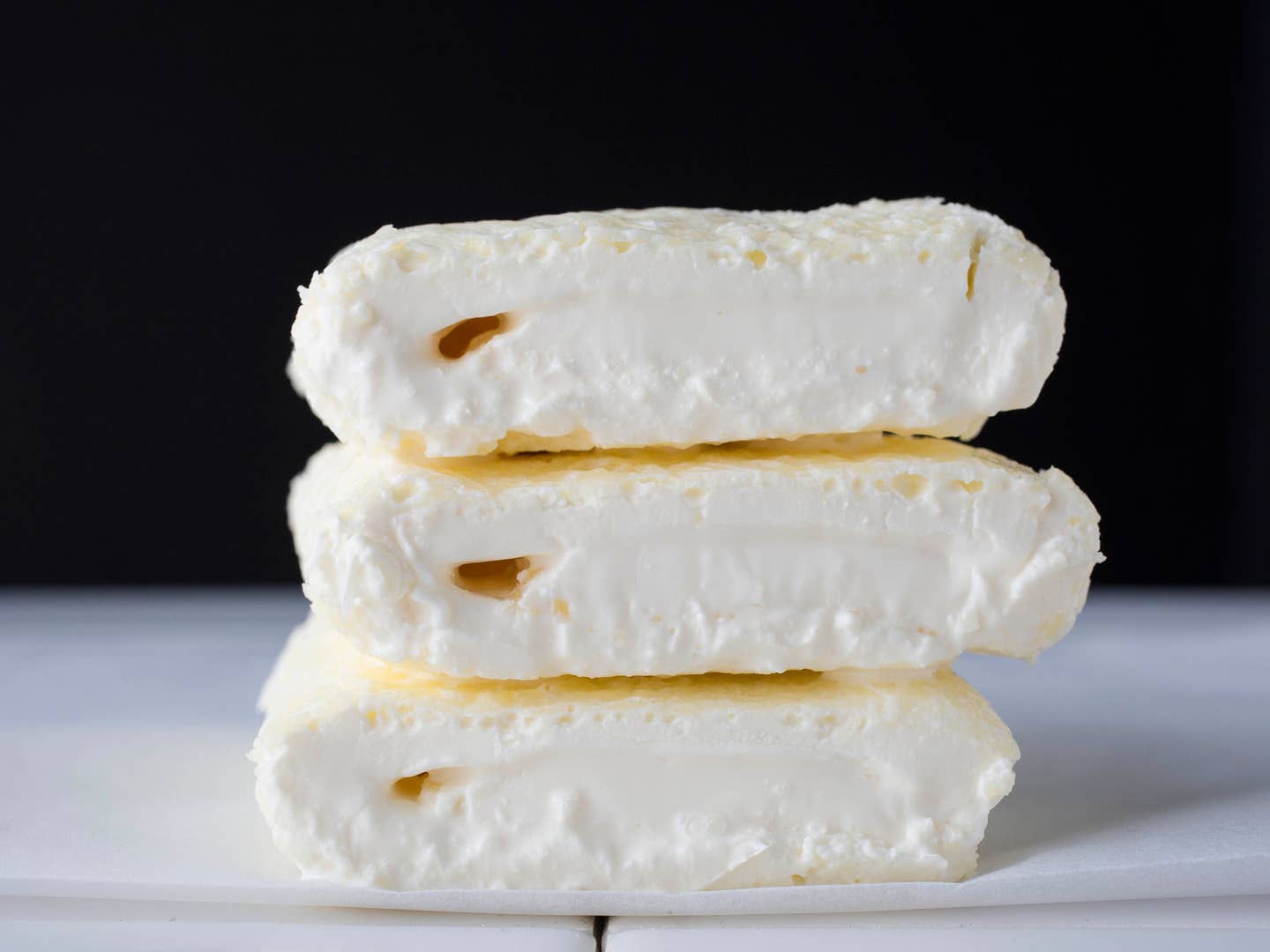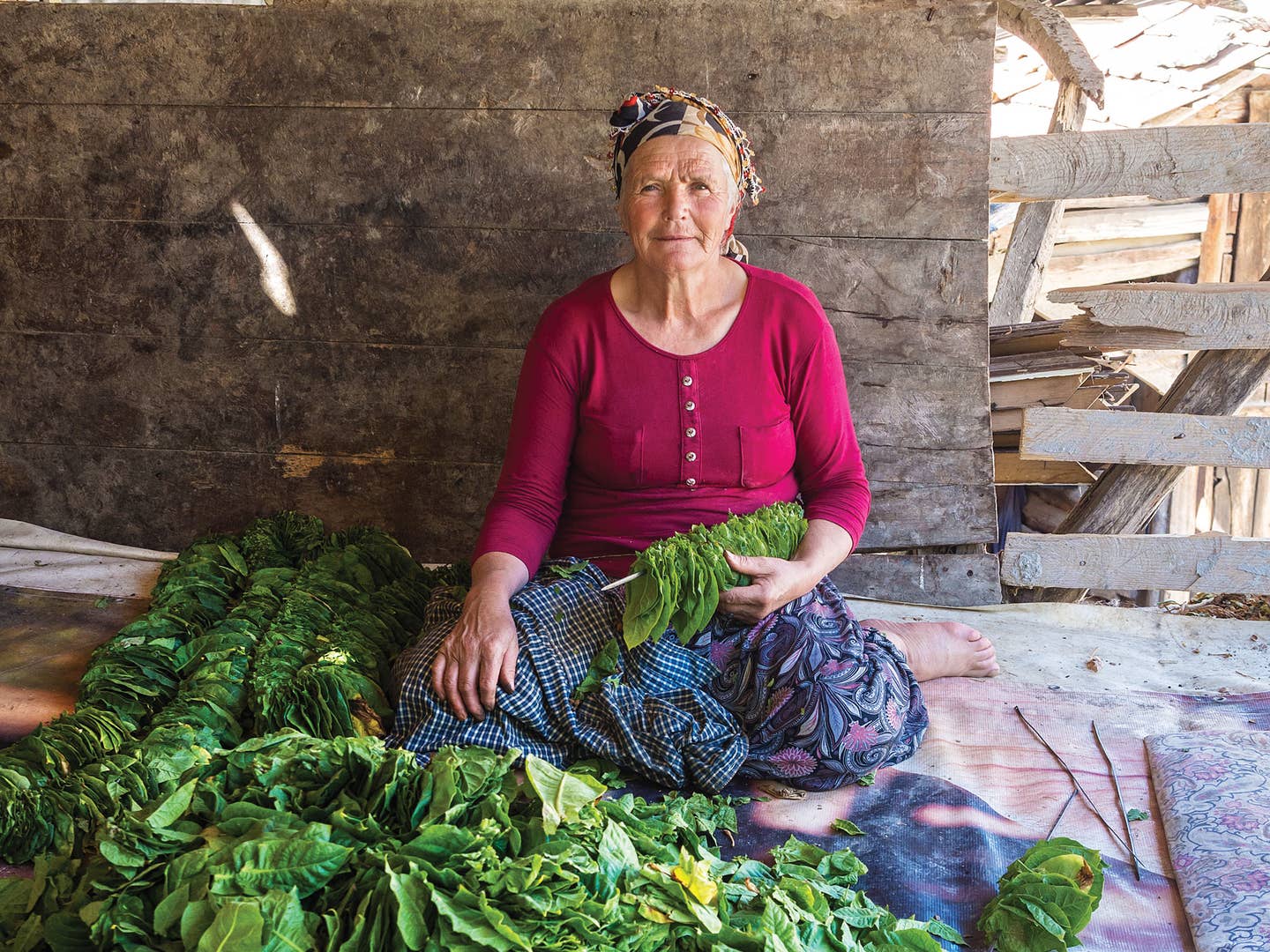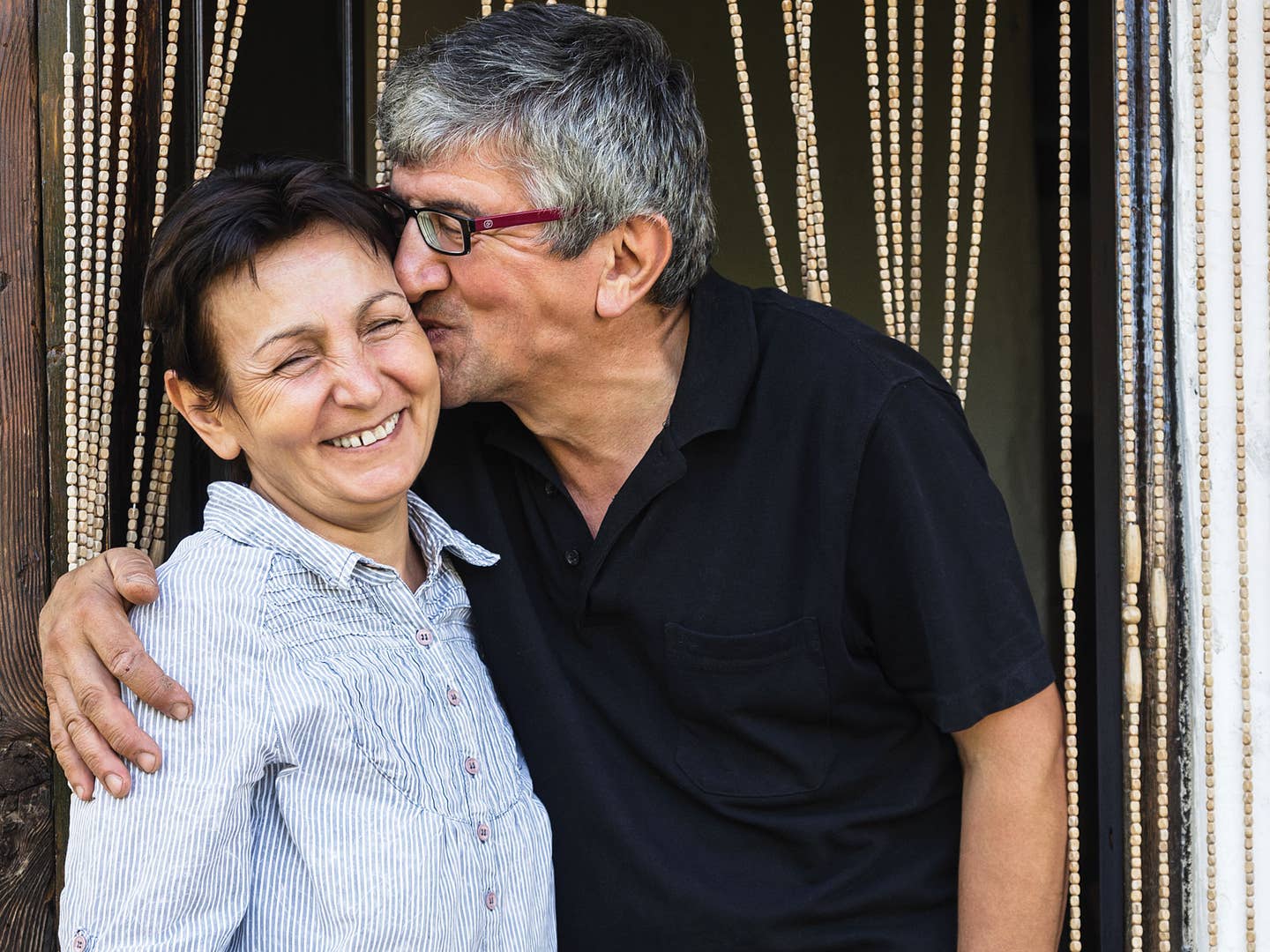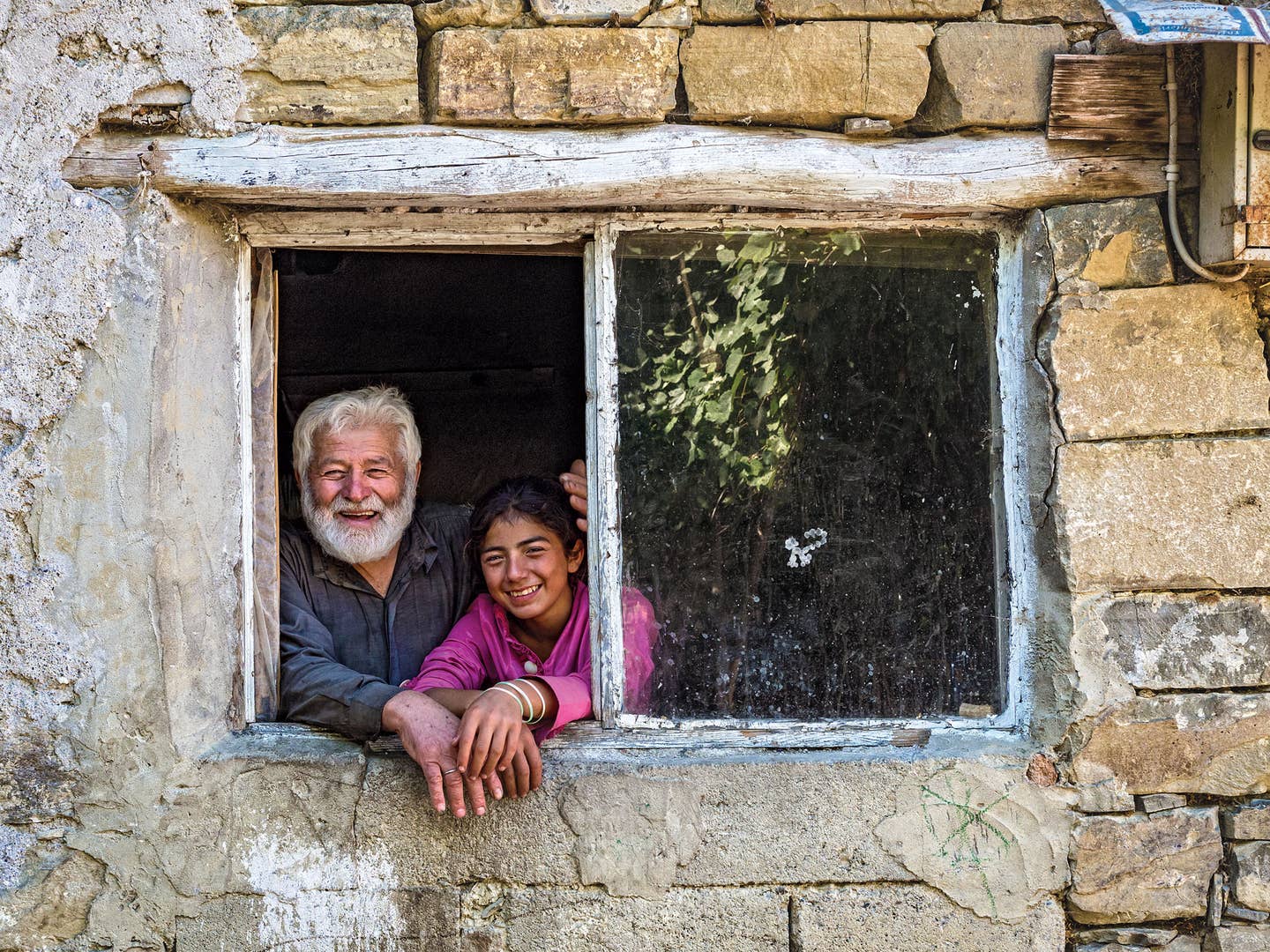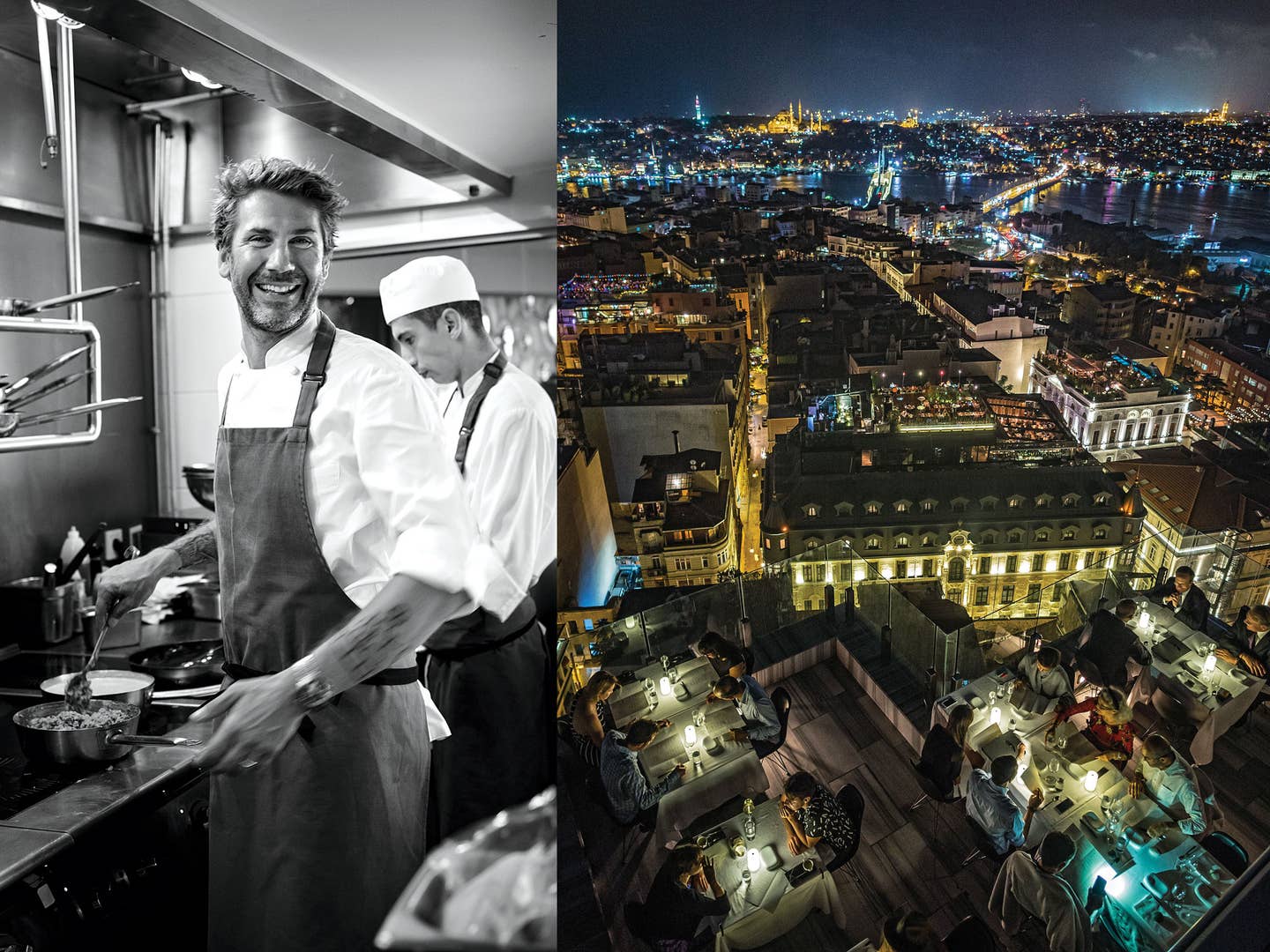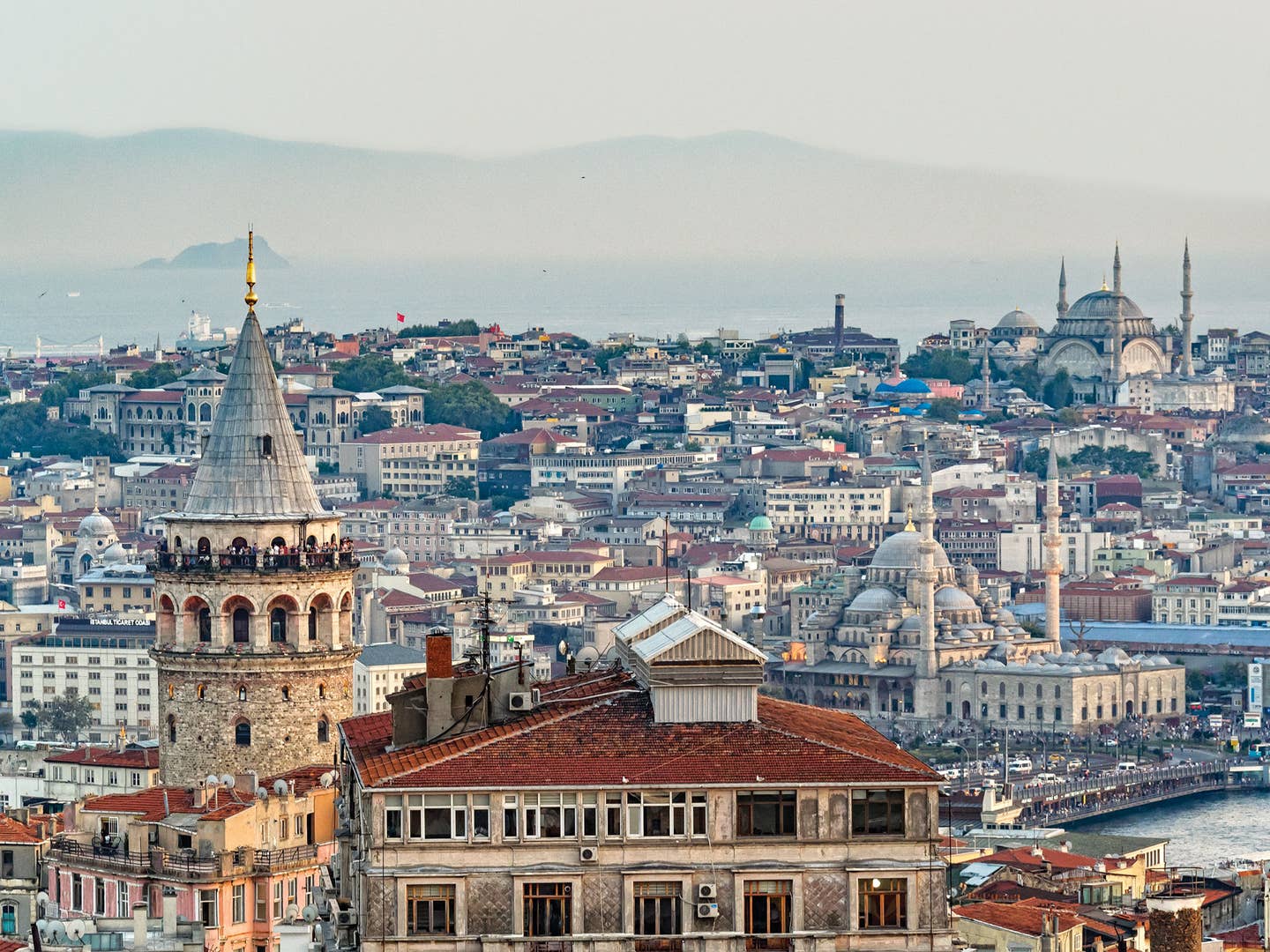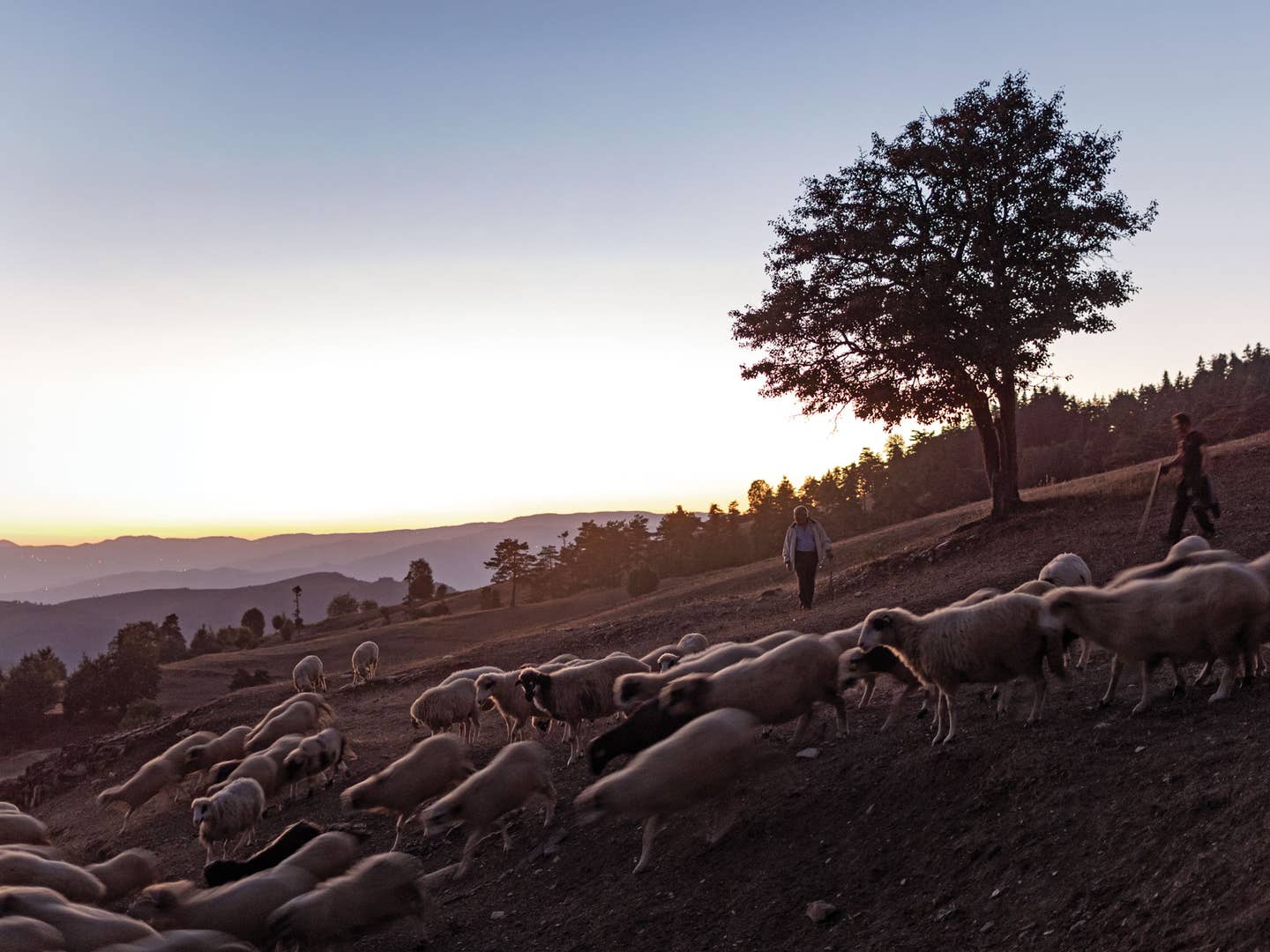
Meet the Chef Who’s Traveling All Over Turkey to Bring Old World Food to Fine Dining
Mehmet Gürs wants you to know the taste of rare mountain lamb
There was never any question of what we would eat for dinner. The Yildirim family has been raising sheep for as long as anyone can remember, and lamb—roasted whole in a wood-burning oven, then served chopped to bits on communal plates—is how they greet every guest. But first, the animal would have to be killed. After a late breakfast of fire-baked flatbread and fresh cheese, the shepherd, Dursun Yildirim, led the animal into the dusty courtyard outside his home. He cradled it in his arms and stroked its neck so gently that, for a moment, it seemed as if he might pet it to death. But it was a knife that actually did the job, and it wasn't long before Yildirim had sheared the animal, removed its organs, and cleaned its entrails one by one. Finally, he got to the colon. Putting one end to his lips, Yildirim blew air into the tube, so that small round pellets of waste dropped out the other end in a pile. From the sidelines, Turkey's most renowned chef observed the ritual. “Remind me not to kiss him,” he muttered. Mehmet Gürs seeks out what most chefs don't. He's found village women so accustomed to folding delicate, tortellini-like pasta called manti that their fingers move in a blur; located the baker in Gaziantep who makes baklava with pastry so thin you can read a newspaper through it; and, in this case, befriended a family living high up in the Canik mountains near the Black Sea that raises an indigenous breed of lamb Gürs thinks so good he has bought as much of the flock as he can. That day, we not only witnessed the butchering, but also watched the family's matriarch roll out a flat, layered bread that she cooked on a piece of curved iron over the fire, napped on the porch to avoid the worst of the day's heat, and later, kept the shepherd company when he and his dogs brought the flock home as the sky turned first purple, then black. And then we sat with the family and ate the lamb that, after the slaughter, had roasted in the outdoor oven all afternoon, with no more seasoning than its own skin. Despite the ample fat on it, the meat wasn't greasy—just mineral-tasting and rich.
Watching us attentively as we ate, the Yildirim clan swapped anecdotes, speaking as proudly about Dursun's daughter's hopes for university as about his grandfather's exploits during the Greco-Turkish War. It occurred to me then what made Gürs so exceptional. It may be commonplace these days for chefs to talk about the stories behind their ingredients, about how knowing the narrative behind a dish can make diners appreciate it more. But how many actually travel to the source of those stories? How many become part of the narrative themselves?
Gürs is the leading crusader for Turkey's traditional foodways, and has offered a lifeline to ingredients—and their producers—in danger of disappearing. Yet he is less interested in mere preservation than in transformation, and his dedication to his culinary heritage is made all the more striking by the fact that his chief establishment, Mikla, is not some rustic outpost or culinary museum devoted to preserving the past, but an elegant restaurant whose creative take on the cuisine of Anatolia—the ancients' word for this part of the world—draws the most glamorous of Istanbul's denizens. Gürs himself is a walking contradiction: a tall, blue-eyed product of a Finnish mother and Turkish father, who grew up in chilly Stockholm but lives in the seemingly opposite—in both temperature and temperament—land of his paternal relatives.
Çankiri, Turkey
A mountain range 300 miles from Istanbul, near Çankiri, where patches of salt baked onto the terrain look like snow.
Anatolian cuisine is a bountiful hodgepodge. It builds on the key ingredients of the Middle East—yogurt, olive oil, bulgur, lamb—with a Mediterranean jolt of fish and fresh vegetables, sharp sheep's milk cheese and juicy pomegranates, and then throws in its very own palate-tingling punch of cardamom, cinnamon, and nutmeg. The long reign of the Ottomans, with their luxurious palace cuisine, added complex flavors and sophisticated techniques, and elegantly fused the savory and sweet. And the Greeks, Sephardic Jews, Kurds, and Syrians all contributed too.
Before Gürs and I left for the mountains, I had spent a couple of days in Istanbul, and even in that short while had discovered an astounding array of tastes in an astounding array of places. To wit: the market in Kadiköy, where fishmongers pull the gills out of the glistening mullet on display, so that the fish look as though they're bedecked with scarlet carnations; a restaurant in Karaköy where the geometrically tiled floors are either grandmotherly old-fashioned or cutting-edge chic, and where the menu is made up of only the luscious, olive oil-poached vegetables called zeytinyağli; a jewel box of a candy shop in Beikta that sells the most almondy marzipan I've ever eaten; an overlit, Formica-tabled place that hawks perfect, almost-crisp flatbreads called lahmacun that come topped with the thinnest smear of spicy ground lamb; the docks down by the Bosphorus where guys grill mackerel, top it with a lemony tomato salad, and stuff the whole thing into a hunk of baguette for the best fish sandwich ever.
And yet where I see diversity and lusciousness, Gürs sees loss. That towering display of precisely diamonded baklava? Made with cheap glucose syrup instead of real honey. The table-bending array of seafood meze dishes we attempt to plow through one night featuring lakerda, a cured slice of bonito? It wasn't as velvety as it should be, thanks to an insufficiently slow salt cure. And that waterside fish sandwich? The bland mackerel was shipped frozen from far-off Norway, not caught in Mediterranean waters. And the bread, well, you call that bread?
Gürs first visited Turkey when he was 15, but only returned permanently years later, and he began his career cooking the kind of upscale but rootless European food that still gets served in many of Istanbul's fine dining restaurants. When Gürs opened Mikla in 2005, it was a nice if unexciting luxury restaurant heavy on the caviar. But he found himself drawn to the high-tech experimentation going on in Spain and, because of his personal background, to the terroir-based cooking emerging out of Scandinavia. He didn't want to just copy those trends. Rather, he was after something that felt genuine to him, food that had something to say about Turkey itself.
But so much of what made Turkish food unique—its ancient artisanal practices, its carefully tended ingredients, its very diversity—had been lost under a kind of dull, unifying blanket of “Turkishness” that anyone who has ever scarfed an uninspired late-night döner kebab knows well. And so it occurred to him that if his Nordic colleagues had gone looking for an authentic cuisine in the wild flora and fauna of Scandinavia, he might be able to find his in the deep-rooted but often forgotten idiosyncrasies of Anatolia. The trick would be finding a way not merely to preserve the past, but to be inspired by it as well—to take it someplace new. “I kept coming back to this question of how we could respect and showcase the work of our ancestors, but not be crushed by their traditions,” he says.
The New Taste of Old Turkey: Recipes From Anatolia
Beef and Lamb Koftas With Mustard
Ground lamb adds rich flavor to traditional Turkish meatballs. Serve them simply with mustard for a first course, or with rice for something more substantial.
Chilled Yogurt and Chickpea Soup (Ayran Aşi)
Packed with green lentils, wheat berries, and black-eyed peas, this filling, tangy soup is brightened with handfuls of fresh parsley and mint.
Lamb Shanks in Red Wine With Creamy Eggplant
A creamy eggplant purée, enriched with béchamel and Gruyère cheese, serves as a bed for meltingly tender lamb shanks, slow-braised in red wine and aromatics.
Freekeh Pilaf With Sumac
Sumac, a brightly-flavored spice, lends color and lemony zing to a side dish of earthy, nutty freekeh—a popular Mediterranean grain.
Skillet-Braised Swiss Chard
We love this quick braised side dish with Swiss chard, but any hearty green will work. Try it with bok choy, kale, or even green or purple cabbage.
Black Mulberry Soup With Kaymak Ice Cream
This pleasantly tart soup is a welcome break from super-sweet desserts. The accompanying ice cream is made from kaymak, a traditional Turkish dairy product.
The answer came in the form of a bearded young anthropologist, with the beatific smile and rounded belly of Buddha. Tangör Tan was a line cook when he started studying for his PhD at the University of Gastronomic Sciences in Bra, Italy. Impressed by his knowledge and sensitivity, Gürs hired him before he had really figured out what to do with him. “One day, I just said to him, ‘Here's a car. Go somewhere, see what you can find,’” remembers Gürs. It took a while for Tan to get the hang of things, but after about a year, he began finding extraordinary products that the restaurant could showcase. Eventually, those individual products cohered into an emphasis on cultural terroir that would transform Mikla from a fancy restaurant with a nice view into ground zero for the development of a creative Turkish cuisine. The day after our lamb feast Tan wants Gürs to meet Hüseyin Genç, a guy who makes vinegar in a room off his kitchen. To get there, we leave the Yildirim family and drive for hours to the parched moonscape outside Çankiri, 300 miles east of Istanbul. Finally, we arrive at a ridge of caramel-colored mountains covered with what look to be patches of snow, though the oppressive heat makes this impossible. Genç is waiting for us there beside a dry white riverbed. “It's salt,” he says. “They say there are galleries of it from here all the way to the Himalayas.” We reach for a taste of it, and sure enough: clean, but intensely salty. You can practically see the wheels of Gürs' mind turn as he asks questions. Would it be possible to get blocks of the salt to the restaurant to use as plates? How would they be harvested and transported? But just as quickly, he is worrying about sustainability. “If we start doing it, others will too.” He looks off in the distance. “And then what? Is there enough? Are we going to ruin this place without meaning to?” From the Test Kitchen: What the Turk is Kaymak?
Kaymak
While English clotted cream and Turkish kaymak may be culturally distinct, they’re actually very similar. Both are made from whole milk cooked until the curds rise to the top. Kaymak curds are denser, and are sold rolled up like a jelly roll; just break them apart and drizzle with honey to serve, or place a dollop on this mulberry dessert soup. Clotted cream curds are sold in a heap, ready to spread. Use both instead of butter on warm toast or with macerated fruit and cookies for dessert. — Farideh Sadeghin, Test Kitchen Director 10-oz. package, $8 at bestturkishfood.com
It's the kind of complication Gürs has become used to considering. After all, most of the producers he and Tan discover are accustomed to working on a very small scale, and in virtual isolation; to suddenly begin supplying the most recognized restaurant in Turkey can have a big impact on their lives and the environment they work in. Take Genç, for example. We follow him from the salt road to a home that is as much garden as it is house. A table is set beneath the cherry trees, and we fall on a lunch as simple as it is vibrant: home-baked bread, fresh sheep's milk cheese and honey, sliced tomatoes, and roasted peppers and eggplant. Genç used to work for the government buying fertilizers, of all things, but was always interested in making his own vinegar. After he retired, he turned his focus more fully to his passion and started producing his own.
Not long after that he met Tan, who spent a day with Genç and his wife, Kezban, watching them work, listening to their story, and occasionally suggesting improvements, like using wooden barrels instead of the steel Genç first employed.
“The amazing thing about him,” Gürs says of Tan, “is that he can fit in totally. And he's so clearly interested in what other people are doing that they open up to him.”
The Faces (and Places) of Anatolia
Nefise Yildirim; Canik Mountains, Turkey
Nefise Yildirim threads tobacco leaves onto a spindle for drying.
Hüseyin and Kezban Genç; Doğanbey, Turkey
Chef Mehmet Gürs of Mikla sources from Turkish purveyors—such as these vinegar producers from the village of Doğanbey—who use old world methods to produce their products.
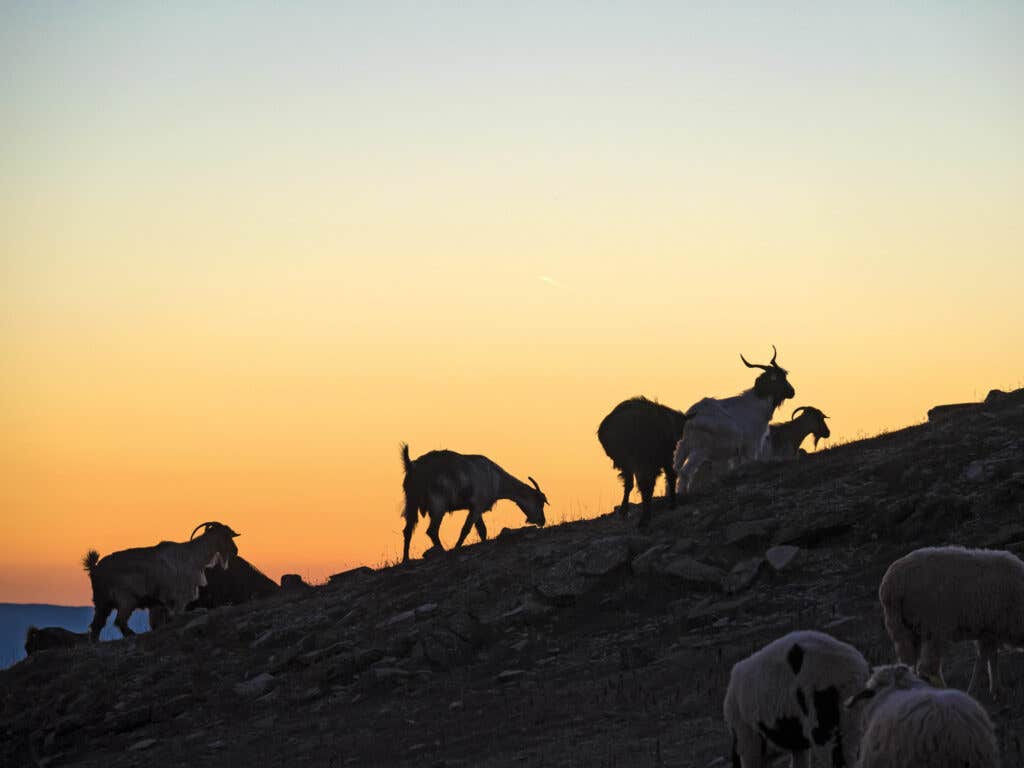
Yildrim family; Turkey
Sheep farmers for generations, the Yildrim family has recently become a supplier for chef Mehmet Gürs of Mikla.
Left: Chef Mehmet Gürs | Right: Istanbul
The view from Gürs restaurant, Mikla, high above the shimmering Bosphorus straight in Istanbul.
After lunch, Genç leads us indoors to show us around his kitchen annex vinegar distillery. Dipping a spoon into an elongated barrel, Gürs samples a bit of the apple, then the pear, then the sour cherry—all of them made from fruit the Gençs grow themselves. Excitement blossoms across the chef's face. “We just met, but I'm already getting ideas for other kinds of vinegar. We'll help them expand, put in a whole wall of barrels here”—he sweeps his arm across the outer wall—“and then we'll get his vinegar in at Mikla, and we'll do something extraordinary with it.” Genç nods in cheerful agreement with the planned reconstruction of his home, happy to receive recognition for what is clearly a labor of love. In celebration, he opens a jar of homemade pickles and passes them around; flavored with garlic and wild celery, they are bright, tart, excellent.
Two nights later, Gürs and I dine outdoors on the balcony at Mikla. The meal starts with one of the restaurant's signature dishes, a crisp, buttery toast miraculously laminated with a meaty grilled anchovy. “You've had the fish sandwich they sell by the Galata bridge, right?” he asks. “When I was young it was the fishermen themselves who would pull up to sell them. They had grills in their boats, and you would step onboard. You'd be wobbling as you ate it, but it was so good, so fresh—the best fast food. So I wanted to do something that was a tribute to that.”
Like his take on that fish sandwich, much of Gürs' cooking transforms the recognizable flavors of Anatolia—the tang of citrus and pickled vegetables; the richness of fresh nuts and olives; the earthiness of bulgur and lamb—into something modern and exciting. As we eat our way through dishes that highlight his and Tan's finds—a voluptuous soup made with raw buffalo milk yogurt, an impossibly delicate manti—Gürs tells me about his first Turkish coffee, the tiny cup poured from a long-handled copper cevze, and how years later, after a mind-blowing cup of coffee at Copenhagen's Noma, he was spurred to open his own coffee roaster and shops, called Kronotrop. There, amid international coffee juggernauts like Starbucks, the baristas teach Turks themselves that good Turkish coffee can be floral and nuanced, that it is often better than its European counterparts—it was, after all, Turkey that introduced coffee to the continent.
Except for the illuminated minarets of Istanbul's many mosques along the shore, it is dark by the time we get to the final savory course. With its accompanying quenelle of plum fruit leather and smear of smoked, charred eggplant, this tender lamb shank is a million miles from the heaping platter of flesh and fat and gristle we ate with our hands back with the shepherd's family near the Black Sea. Yet in its richness, I'm reminded that both sheep shared a flock. I take another bite, and watch the twinkling lights of ships from that same sea slowly ply their way through the ancient Bosphorus below.
Experience Anatolia: A Traveler's Guide to Old Turkey
Where to Eat and Drink
Çiya
Whether they're locals or visitors, everyone's favorite kebab place is actually three restaurants, all crowded on a single block near the Kadiköy fish market. The menus are the result of deep research into the geographic and historical varieties of Turkish cuisine, and are full of unusual—and unusually delicious—dishes like roast borage and sour kebabs with pomegranate juice.
Caferağa Mah. Güneşlibahçe Sk. 48 B
Halil Lahmacun
The atmosphere at this joint that hawks just a handful of items may be all Formica tables and bad lighting, but the lahmacun, with its delicate crust and spicy smear of ground lamb, is among Istanbul's best. The pide—its chewy, boat-shaped dough filled with cheese and tomatoes—also has the power to make you completely forget about pizza.
Caferağa Mah. Güneşlibahçe Sok. No. 26, 34710
Karaköy Lokantasi
With its patterned tile floors and deep blue walls, this family-run restaurant draws a noticeably hip clientele. At lunch, the menu is crowded with delicious interpretations of the olive oil-braised dishes called zeytinyağli, like stewed artichokes or white beans in tomato. At night, it turns into a meyhane, or pub, specializing in small plates called meze.
Kemankeş Cd. No. 37 A
Kronotrop
With three locations in Istanbul and an arsenal of Chemexes, espresso machines, and Aeropresses, Gürs' urbane coffee shops look like they could be located in any bean-obsessed city from Portland to Melbourne. What distinguishes these is not just their own roaster, but their Turkish coffee, which, while clinging closely to the traditional method, nevertheless allows the sweet, subtle flavors of the coffee to come through.
Kuloğlu Mh., Firuzağa Cami Sk. 2 B, 34433
Mikla
The rooftop restaurant that disproves the commonly held notion about restaurants with views, Gürs offers a menu that makes creative and elegant use of the products and techniques he and his team have sourced throughout Turkey and serves it in a setting incredibly freighted with beauty and history.
Hotel Marmara Pera, Meşrutiyet Cd. No. 15, 34430
Where to Stay
Hotel Empress Zoe
The 25 rooms of this exquisitely designed hotel are spread across five townhouses built around a 15th-century garden near Topkapi Palace. Each is decorated with indigenous textiles and Islamic folk art.
Akbiyik Cd. No. 10
Hotel Marmara Pera
Located just off bustling Istiklal Street, this high-rise hotel has spectacular views of the Bosphorus and is host to Mehmet Gürs' Mikla restaurant. There's also a very happening outdoor cocktail bar on the top floor.
Meşrutiyet Cd. Tepebasi, 34430
What to See
The Spice Bazaar
Also known as the Egyptian market, and located by the New Mosque, the 85 shops here are a wonderland of coffee, dried fruit, Turkish delights, and, of course, spices.
Çiçek Pazari and Tahmis streets, Eminönü quarter, Fatih district
Keep Reading
Continue to Next Story

